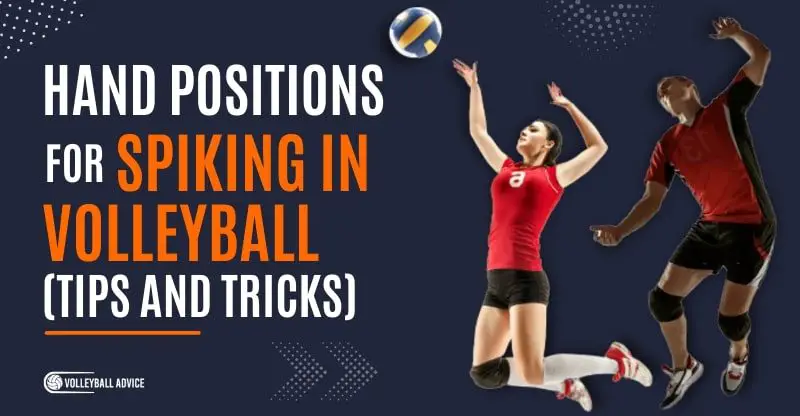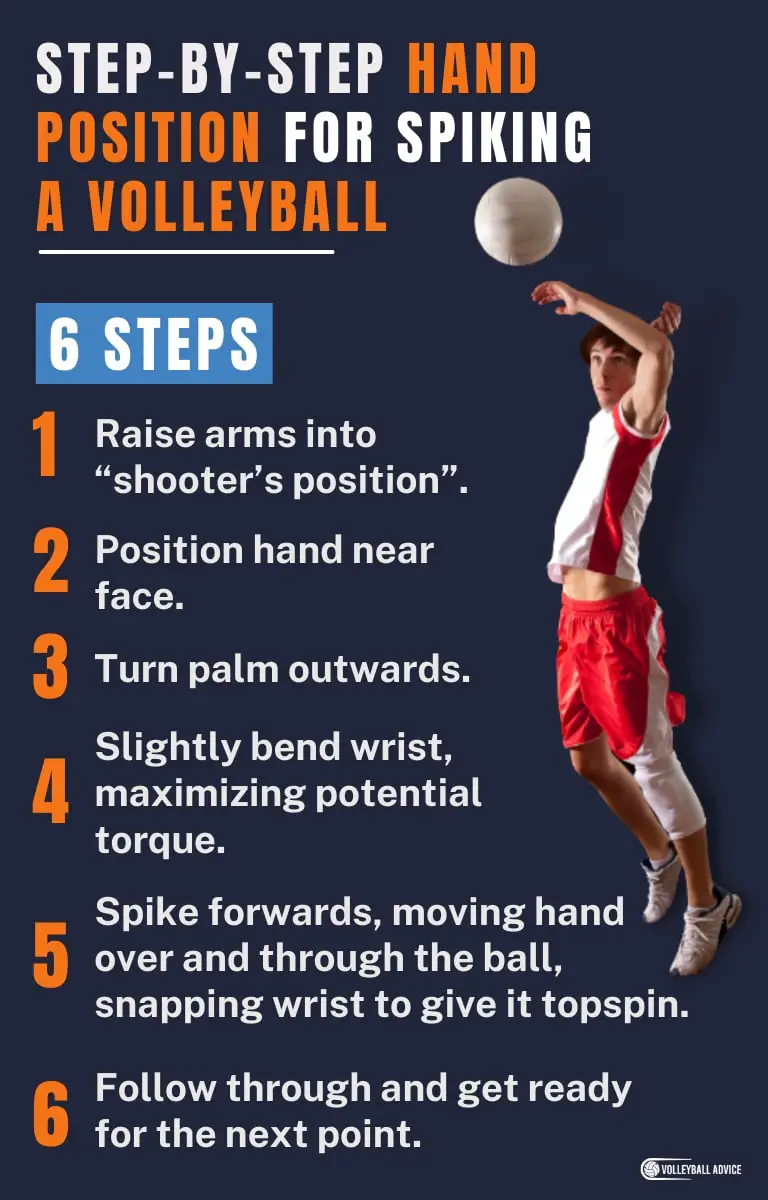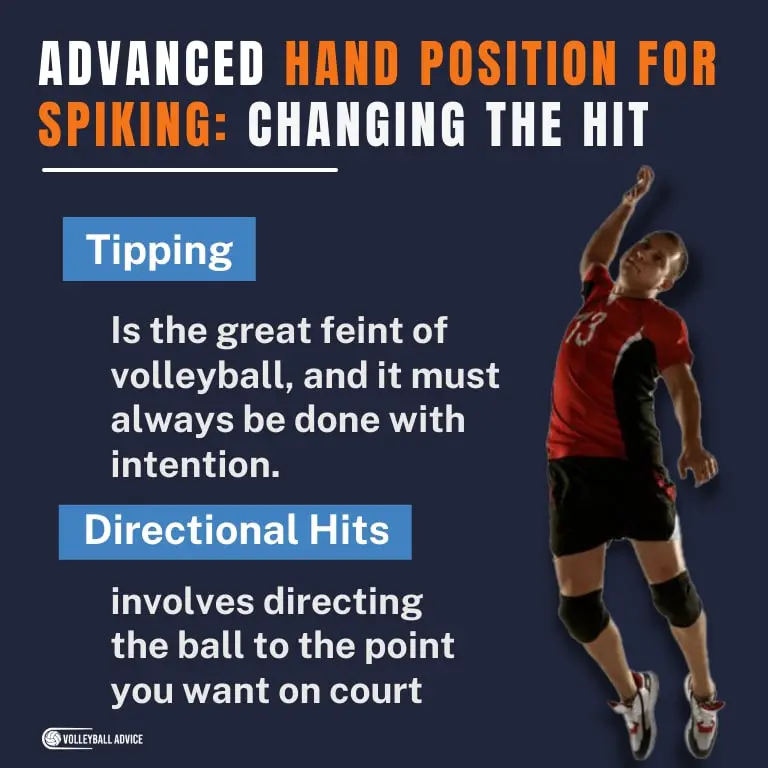Hand Position for Spiking in Volleyball (Tips and Tricks)
Some links in this article are affiliate links, which means I earn from qualifying purchases.
Hand position in spiking can make a huge difference. Whether you’re trying to roll, bounce, or tip the ball all depends on how your hand is positioned and reacts to the ball, changing the dynamic of your attack.
So, what is the hand position for spiking in volleyball? The hand position for spiking in volleyball begins with the arm in shooter position and elbow raised above the head, with the hand open and relaxed and the palm facing outward, away from the face. On contact, the hand position will either remain open, tipping with the fingers, or snap downwards to create topspin.
How you position your hand on contact with the ball will determine its trajectory, and once that happens there’s no turning back. Setting up properly with good form every time will allow you to retain control and dominate the court with your attacks.
In this article, I’ll be discussing:
- Setting up proper hand position and executing the spike
- Exercises to strengthen your hand and wrist
- The most common mistake made when spiking
What Is The Proper Hand Position For Spiking?
Proper hand position for spiking begins with the arms, because if the arms aren’t in the correct place your hands won’t be either.
Assume the “shooter’s pose” – you may know this as the “archer’s pose” or just simply the spiking position. It involves your spiking arm being raised with a high elbow, your hand resting near your face. It’s called “shooter’s” or “archer’s” because it should look like you’re holding an invisible longbow and are about to lose an arrow.
Your hand should be open and relaxed, facing outwards or away from your face, with your wrist slightly bent. While this might feel strange at first, there’s a good reason for doing so, and it all comes back to our physiology as athletes.
Body mechanics tells us that this is the scientifically best way to hit a volleyball: aligning your hand position in this way informs the body that it will need to rotate the wrist, elbow, and shoulder in order to spike the ball, adding power and torque to your attack. Moving your arm through the spike will whip your arm forward faster than a flat-motioned hit, resulting in a better spike.
Because of the motion of the arm here, rotating through and over the ball as we hit, topspin will automatically be generated – even if it’s only a little. If you find yourself struggling to put topspin on the ball, slow down your movements and make them bigger, spiking over and through the ball. Do this slowly at first, and add pace as you understand the interaction.
It is ok to hit flatly when first starting off, but topspin gives the ball control and accuracy, preventing it from floating like a serve or drifting out of bounds. This again is basic science.
Let’s review. Here’s the step-by-step hand position for spiking a volleyball:
Step 1
Raise arms into “shooter’s position”.
Step 2
Position hand near face.
Step 3
Turn palm outwards.
Step 4
Slightly bend wrist, maximizing potential torque.
Step 5
Spike forwards, moving hand over and through the ball, snapping wrist to give it topspin.
Step 6
Follow through and get ready for the next point.
Related Article: How To Spike A Volleyball If You’re Short (7 Tips That Work)
Advanced Hand Position For Spiking: Changing the Hit
Now that we’ve learned how to position your hand to spike, it’s time to learn how to control it.
The process detailed above demonstrates how to spike, and while there’s nothing wrong with this, it’s always good to have other options in your toolkit while attacking. Accuracy is a prized skill for spikers, and one which is absolutely necessary to play at the highest levels with any semblance of competency.
I’m going to cover two small hand position changes that will allow you to hit tips and directional hits (including cross spikes and inside-out spikes).
Want to learn more about the different types of spikes? Check out: 16 Types of Spiking In Volleyball.
Tips
Tipping is the great feint of volleyball, and it must always be done with intention. In the hands of a great spiker, it’s not a defensive tool but an offensive weapon, and one which can score just as many points as your harder hits.
For tipping, begin with your hand position as normal, moving through the motions. Contact the ball with the tips of your fingers instead of the palm of your hand, however, softly tipping it over the net around the ten foot line.
The hand position for this can vary widely, but I prefer to tap it with my middle three fingers pressed tightly together.
Your hand should be in-line with the fingers, forming a spear of sorts. This gives me consistency and a little more control than soft fingers would otherwise.
If you find your pinky getting in the way, retract it to hold against your thumb and tip as usual.
Directional Hits
This kind of spiking involves directing the ball to the point you want on court, and is incredibly useful. The arm motions, footwork, and jumping all remain the same as a straight hit – the only change is the hand positioning.
For a cross hit – or any spike moving across the inside of your body (for right handed hitters this is anything landing on the left side of the court), turn your hand slightly to the left and contact on the right side of the ball. This will give it an off-center spin, angling it across and to the left. For left handed hitters, repeat this advice but to the right instead.
For an inside-out hit (for right handed hitters, any spike landing on the right side of the court), do the opposite. Maintain your hand facing outwards, away from your face, and contact on the left side of the ball, sending it rightwards.
You can use these same hand positions to slice the ball – simply don’t hit it as hard.
While you can also angle the ball by turning your body and shoulder, hitting straight to where you want it to go, this is easily blocked and not sustainable in the long run. By training your hand position and practicing it before games, you will be able to outplay your opponents and have total mastery over your spikes.
Related Article: Footwork For Spiking: Technique, Drills, Errors
The Biggest Mistake: Forward Facing Hands
There is really only one mistake when it comes to hand positioning in volleyball, and that is facing your spiking hand forward instead of outwards, away from your face.
This mistake is extremely common among beginners, most of whom haven’t become comfortable in the “shooter’s pose” yet and are still figuring out how their joints work together in volleyball.
This is also why flat, weak spikes are commonly seen at that level, even by players who clearly have the mass to spike harder.
Facing your spiking hand forward does two things:
- First, it immediately lowers your elbow (unless you manage a cobra-like pose). This turns your body forward also, eliminating the power that comes from your upper body rotation when hitting. It can even throw off your footwork.
- Second, it eliminates the amazing torque potential that the “shooter’s pose” gives you, turning multiple rotations of wrists, elbows, and shoulders into a simple lever action, forcing your elbow alone to do all the work. This makes your spikes weak and almost impossible to put topspin on, eliminating your control in turn.
As players progress, this hand position is eventually corrected, but it’s not uncommon for players to revert slightly to forward hands when tired or lazy. This clashes with their otherwise good form, and they may be frustrated wondering why their spiking suddenly deteriorated.
Coaches, be quick to pick up on your players doing this and address it immediately, whether in-game or practice. The faster they are made aware of it, the more mindful they will be in the future, and their spiking will benefit from it.
Hand Position Spiking Drill: Downball Progression
This is my top recommended spiking drill to train hand position:
- Begin with a volleyball and a wall (or partner!)
- Toss the ball in the air and spike it against the floor so that it bounces against the wall and back to you. How did it feel? Did you notice any spin on it? What was the power like? Be mindful of where your arms and hand position was, and try again. Any difference?
- Focus on getting your hand over and through the ball, snapping your wrist to give it spin.
- Keep your elbow high and change your power and position as you practice.
- When you feel comfortable, continuously spike from floor-wall-self, moving your feet to be in the right position and always focusing on as much topspin as you can muster.
This will train consistency for your hand position and build confidence. When ready, take it to the net and practice with your team. With enough time, you’ll notice a marked improvement.
Related Article: How To Practice Spiking A Volleyball With No Net (10 Drills)
Strengthening Your Hand & Wrist For Spiking
The best exercises to train for spiking should focus on your core and shoulder muscles, as these are the ones that give the movement its speed and power. One exercise that is beneficial to include for your wrists and hands, however, is the “wrist roller”.
You can make this at home or use one at the gym, but it includes a simple setup of a small bar (or wooden stick) with some kind of rope attached to a weight on the end.
I like to use a mobility stick from my gym and a resistance band tied through a weighted plate, as this lets me increase or decrease the weight I’m working with easily.
Side note: if you don’t already have a resistance band as a competitive volleyball player, I highly recommend getting one to help warm up with and train your core. Here is one option.
Stand with your arms in front of you and roll the stick in one direction to raise the weight, only moving your wrists and hands to do so.
Once it reaches the top, lower it again, making sure not to let it slip and unravel.
The focus of this exercise is not on how fast you can do this, but how much you can control it.
Repeat this ten times per set.I like to do five sets at the end of my workout, but if you need to do less that’s fine.
Work your way up to what’s challenging and push yourself a little further each session for growth.
Most trainers recommend just standing with your arms out:
However, I like to take it one step further:
- Find yourself a squat cage or other rack and raise the safety arms to a comfortable height to rest your arms on.
- Roll as usual, making sure not to rush the movements and keep your arms on the rack.
- This will eliminate any accidental counterweight movements from free standing to make the movements easier, and force your hands and wrists to do the work on their own.
As always, consistency is king, and you will see (and feel) real development in your hands and forearms after adding this to your routine. Good luck!
Related Article: How To Spike A Volleyball Straight Down
Frequently Asked Questions:
What Part Of The Hand Do You Use To Hit In Volleyball?
Always spike with the palm of your hand, as this will give you the most power and control when attacking. The only exceptions to this is when you’re tipping – when you use your fingertips – or when using an advanced backhanded trick in beach volleyball.
Can You Spike With A Closed Fist?
Yes! Many players choose to spike with a closed fist when the ball is close to the net. This reduces the chance that they will touch the net and lose the point while enabling them to hit downwards, bouncing the ball impressively off of the ground.
Hand Position For Other Volleyball Skills
- Hand Position For Volleyball Bumps, Passes, and Digs (6 Rules)
- Hand Position For Setting In Volleyball (7 Steps)
- Hand Positions For Volleyball Serving (3 Types)
About The Author
Ailan Samuel is a writer and athlete who has played volleyball at the university, club, and national level since 2012. He has competed successfully in both beach and indoor competitions, resulting in four silver and two gold medals, and was awarded the Half-Blue while playing in Scotland. He received his MA in English and Medieval History from the University of St Andrews, Scotland, and is currently studying for his MA in Publishing and Creative Writing at Bournemouth University.



